Pool ventilation: features, requirements, design
Pools are classified as objects in which proper ventilation plays a crucial, if not decisive role. In the absence of proper air exchange, the atmosphere in the room will very quickly cease to meet the requirements of SanPiN and SNiP, which are mandatory.
We will talk about the main features of the design and requirements for ventilation systems of private pools.
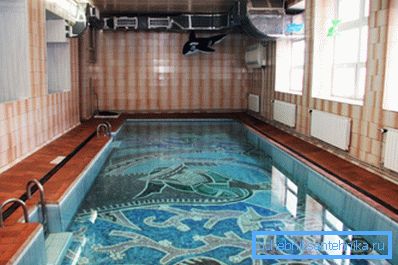
Swimming pool ventilation system
Purpose

Swimming pool ventilation systems and the system as a whole have a number of features and differences from similar general-purpose systems (see also the article Sauna ventilation: choosing the right option and device features on your own).
If the main task in conditioning in residential and business premises is to ensure a sufficient supply of oxygen with fresh air, then in the case of a pool, this problem is solved along the way; the main purpose is to provide the specified humidity in the conditions of intensive evaporation of moisture from the surface of the water mirror.
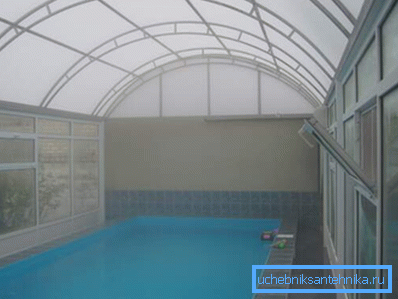
It should be understood that it is impossible to reduce the evaporation rate below certain values, since, in addition to the requirements for air humidity, there are strict limits for the temperature regimes of water and air, which are regulated by regulatory documents.
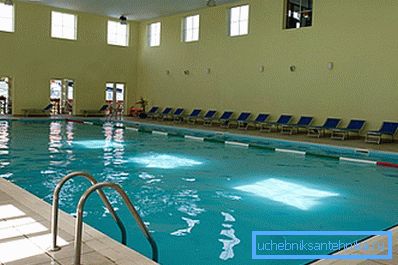
To understand how important the role of well-organized aeration is, it is enough to consider the consequences of its absence:
- In the absence of supply and exhaust air flows, relative humidity will increase dramatically, with the bulk of the vapor accumulating above the water, and the swimmer will immediately feel unpleasant stuffiness, lack of oxygen and other undesirable symptoms that make further water procedures not only uncomfortable, but also dangerous;
- The increasing humidity of the air and its temperature will lead to the fact that the enclosing structures and other elements of the structure will become colder than the dew point, and abundant condensate will begin to form on their surface. This effect is known as the "weeping walls";
- As a result, after a few hours to conduct classes and procedures in the water will become dangerous. After a while, being in the bathhouse of the pool itself will turn into something like a visit to the bath;
- Due to the abundance of condensate, the structural details of the structure will start to corrode and deteriorate, and the moisture flowing from the walls will form puddles on the floor. This will lead to even greater evaporation and an avalanche-like increase in air humidity, turning the room into a steam room.
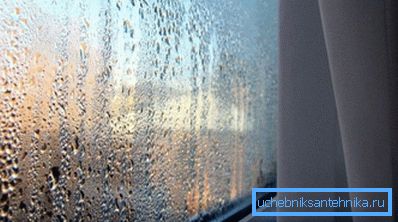
Note! The ventilation system of a room with a bathroom should solve two problems: ensuring the required humidity of the air is first of all, and ensuring the supply of oxygen is along the way.
Special features

Ventilation in the pool of a private house has a number of characteristic features that are important to know and understand.
These features are dictated not only by the presence of an open mirror of a large area of water, but also by many other factors, such as:
- structure construction;
- requirements for temperature parameters;
- sanitary and hygienic;
- medical requirements.
First of all, it is necessary to take into account the increased moisture content in the removed air, which leads to an abundance of condensate in the air ducts, ventilation shafts and ducts. This means that the canals and mines should be equipped with special pallets for collecting water and removing it. At the same time, it is necessary to provide unimpeded and convenient access for the personnel to the pallets and valves.
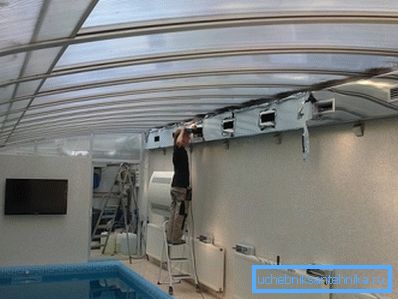
In addition, the very order of the organization of ventilation flows and the location of the input and output openings are changing.
The scheme of ventilation in the pool is different from that in a normal room, especially in such points:
- Since the main task is to remove the maximum amount of moisture, it should be remembered that humid air is lighter than dry, and therefore accumulates under the ceiling. Therefore, exhaust vents should be located there;
- Too intensive movement of air above the water and near the bath will lead to the fact that a wet and naked person will begin to freeze and feel discomfort.. On the other hand, the absence or weakness of these streams will lead to the accumulation of vapors directly above the water, which will lead to unpleasant stuffiness;
- The air supplied to the room must be heated in order to avoid cold drafts in the winter and indoor temperature drops.. Also, cold streams are fraught with the occurrence of cold symptoms in bathing.

Note! Unlike conventional systems, the ventilating system of the pool has a peculiar layout of the air flow: supply below, exhaust hood - under the ceiling.
Another feature is the significant differences (almost twofold) in the humidity of the incoming air, depending on the weather conditions outside and the time of year. This leads to the fact that the calculation of the ventilation of the pool must be made taking into account the different modes of intensity.

To ensure the normal operation of the system, temperature sensors are usually used at the air intake points from the street, which control the inclusion of additional exhaust systems.
Regulatory requirements

In accordance with the standards adopted in the Russian Federation, the design of the ventilation of the pool is carried out on the basis of such input data:
- The water temperature is assumed to be 30 - 32 ° C, while according to European standards, this temperature is 28 ° C;
- The air temperature should exceed the water temperature by 1 - 2 ° C. According to EU standards, the difference is 2-4 ° C, but not higher than 34 ° C;
- The permissible maximum in relative humidity is 65%, but for private structures it is customary to reduce this figure to 45-50%, since even a multiple decrease in relative humidity does not cause discomfort in a person, which cannot be said about raising it;
- The intensity of gas exchange is usually determined by calculations, but it should not fall below 80 cubic meters per hour per adult person;
- The wind speed (movement of the ventilation flow) in the area of the bath should not exceed 0.2 m / s;
- To prevent the formation of stagnant zones, air exchange in rooms with swimming pools should be carried out with no more than half a predominance of exhaust over the inflow;
- Ventilation system - forced-air, forced, with mechanical impulse. In addition, it should be independent, that is not connected with the general aeration system of the cottage, and autonomous;
- Ventilation units should be selected taking into account the possibility of their operation in at least two modes: independent operating and supply units for this mode are included in the non-working period, and during the working day and procedures additional installations are attached to them, which together with the first are capable of providing the necessary gas exchange ;
- The value of the internal section of the mines and channels is determined by calculation based on the values of wind and gravitational pressure and pressure generated by the inlet part.
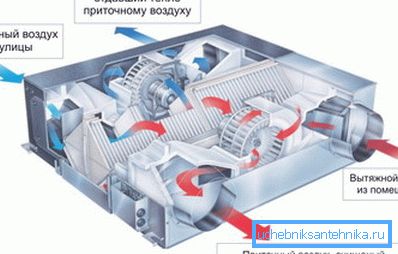
Note! From the analysis of regulatory requirements, we can conclude that the framework is set fairly rigid, so the only way to ensure the required level of humidity is intensive gas exchange and dehumidification.
Drainage is carried out using condensation dehumidifiers, where the air flow is passed through a system of cold surfaces on which moisture condenses. These are high-tech installations that are able to completely solve the problem of humidity, but their price is very high.
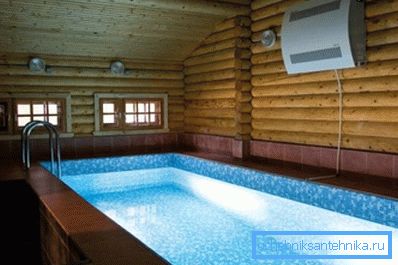
As a rule, dehumidifiers are used in conjunction with the supply and exhaust system. Hygrostats control the inclusion of two or three cars in case of need, when, for example, in the summer heat, ventilation fails to cope with its task and the humidity rises above the set limit.
Tips for novice designers
Finally, we want to give a few brief recommendations to those who are going to make a draft of the pool ventilation and build the system with their own hands.
The pool area (water mirrors) is usually in the range of 18 - 50 square meters. Around the pool there should be bypass paths from 1 to 3 meters wide.

The height of the room should be from 4 to 6 meters, while a large glazing area is desirable (up to 60%), and water heating should pass along the perimeter of this glazing.
Private facilities are designed on the basis of their short-term and occasional use, while the number of people swimming at the same time is taken as 1-3 people.
Ventilation grilles are best made to maximize the area to provide the desired values of the speed of air flow. In this case, it is desirable to strive for the implementation of the principle of pressure ventilation.
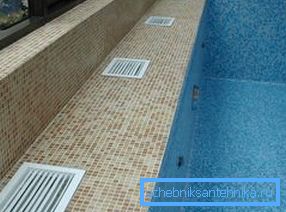
If possible, it is advisable to use a water surface curtain system at a time when the structure is not in use. With a small volume and floor space, it is better not to place the supply grilles on the floor or walls located near the bath.
Conclusion
Pool ventilation has a number of unique features. It is designed according to its own rules and regulations on the basis of the requirements of SanPiN and SNiP (see also the article Ventilation in the Steam Room - the purpose and features of the arrangement).
For clarity, a review of such a system is shown in the video in this article.